英语词汇学论文
- 格式:doc
- 大小:13.50 KB
- 文档页数:2
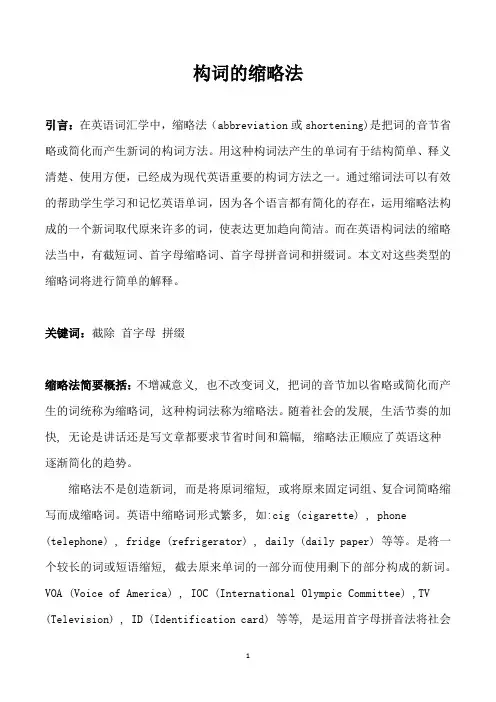
构词的缩略法引言:在英语词汇学中,缩略法(abbreviation或shortening)是把词的音节省略或简化而产生新词的构词方法。
用这种构词法产生的单词有于结构简单、释义清楚、使用方便,已经成为现代英语重要的构词方法之一。
通过缩词法可以有效的帮助学生学习和记忆英语单词,因为各个语言都有简化的存在,运用缩略法构成的一个新词取代原来许多的词,使表达更加趋向简洁。
而在英语构词法的缩略法当中,有截短词、首字母缩略词、首字母拼音词和拼缀词。
本文对这些类型的缩略词将进行简单的解释。
关键词:截除首字母拼缀缩略法简要概括:不增减意义, 也不改变词义, 把词的音节加以省略或简化而产生的词统称为缩略词, 这种构词法称为缩略法。
随着社会的发展, 生活节奏的加快, 无论是讲话还是写文章都要求节省时间和篇幅, 缩略法正顺应了英语这种逐渐简化的趋势。
缩略法不是创造新词, 而是将原词缩短, 或将原来固定词组、复合词简略缩写而成缩略词。
英语中缩略词形式繁多, 如:cig (cigarette) , phone (telephone) , fridge (refrigerator) , daily (daily paper) 等等。
是将一个较长的词或短语缩短, 截去原来单词的一部分而使用剩下的部分构成的新词。
VOA (Voice of America) , IOC (International Olympic Committee) ,TV (Television) , ID (Identification card) 等等, 是运用首字母拼音法将社会组织、政治组织或特殊名词短语以及技术术语的名称的首字母结合起来构成的新词。
一、截短词截短词是截除原词的某一(或某些)音节或“截头去尾”的方法产生新词的构词方法。
在这其中,分为截除词尾、截除词首、截除首尾和截除词腰。
大约自18世纪, 英语中出现了截短词, 如笛福在《鲁滨逊漂流记》中用了though的截短形式。
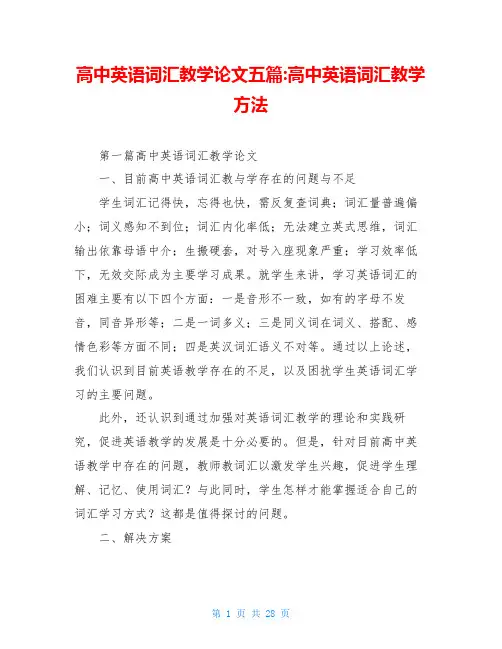
高中英语词汇教学论文五篇:高中英语词汇教学方法第一篇高中英语词汇教学论文一、目前高中英语词汇教与学存在的问题与不足学生词汇记得快,忘得也快,需反复查词典;词汇量普遍偏小;词义感知不到位;词汇内化率低;无法建立英式思维,词汇输出依靠母语中介;生搬硬套,对号入座现象严重;学习效率低下,无效交际成为主要学习成果。
就学生来讲,学习英语词汇的困难主要有以下四个方面:一是音形不一致,如有的字母不发音,同音异形等;二是一词多义;三是同义词在词义、搭配、感情色彩等方面不同;四是英汉词汇语义不对等。
通过以上论述,我们认识到目前英语教学存在的不足,以及困扰学生英语词汇学习的主要问题。
此外,还认识到通过加强对英语词汇教学的理论和实践研究,促进英语教学的发展是十分必要的。
但是,针对目前高中英语教学中存在的问题,教师教词汇以激发学生兴趣,促进学生理解、记忆、使用词汇?与此同时,学生怎样才能掌握适合自己的词汇学习方式?这都是值得探讨的问题。
二、解决方案教师可通过创设相关的情景或语境教词汇,学生能从中领会并记忆深刻。
例如学习《汤姆索亚历险记》时,教师可让学生扮演其中不同的角色并让其即兴发挥,同学们可对其提问。
在比较真实的语境中呈现课文和单词,能激发学生的学习兴趣,加深他们的理解,可谓一举多得。
通过语义比较教词汇,很多英语单词意思相近但是用法却略有差异。
在呈现这样的词汇时,可以通过举例子进一步说明。
例如,smile,laugh和grin都是“笑”的意思,这时教师应从具体涵义和例句上加以区别:smile指既不开口也不出声的笑;laugh强调出声的笑;grin侧重露齿的笑。
这样学生就能明白三者的区别与具体用法。
通过构词法教词汇。
众所周知,只要掌握构词法,大量词汇的记忆是有迹可循的。
熟知英语词根,词缀或词干,了解单词的组合规律,这样以来单词记忆就如鱼得水。
通过联想教词汇,在呈现新词汇时如果能与其他相关的词一起出现,让学生理解其中的关系来学习新词,温故知新,学生的记忆更深刻。
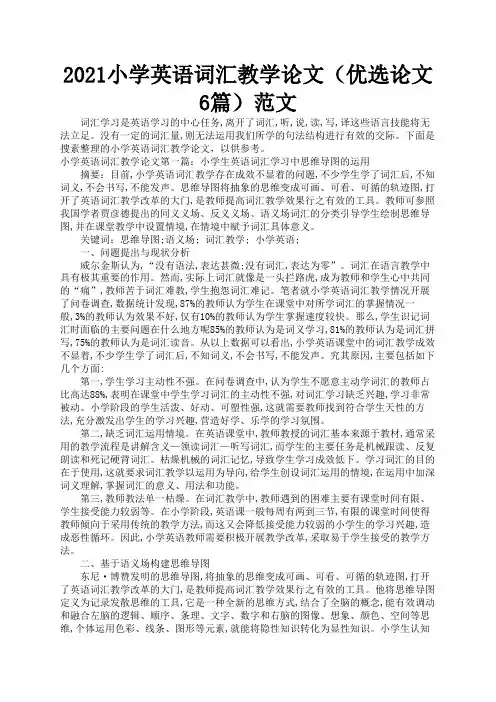
2021小学英语词汇教学论文(优选论文6篇)范文 词汇学习是英语学习的中心任务,离开了词汇,听,说,读,写,译这些语言技能将无法立足。
没有一定的词汇量,则无法运用我们所学的句法结构进行有效的交际。
下面是搜素整理的小学英语词汇教学论文,以供参考。
小学英语词汇教学论文第一篇:小学生英语词汇学习中思维导图的运用 摘要:目前,小学英语词汇教学存在成效不显着的问题,不少学生学了词汇后,不知词义,不会书写,不能发声。
思维导图将抽象的思维变成可画、可看、可循的轨迹图,打开了英语词汇教学改革的大门,是教师提高词汇教学效果行之有效的工具。
教师可参照我国学者贾彦德提出的同义义场、反义义场、语义场词汇的分类引导学生绘制思维导图,并在课堂教学中设置情境,在情境中赋予词汇具体意义。
关键词:思维导图;语义场; 词汇教学; 小学英语; 一、问题提出与现状分析 威尔金斯认为,“没有语法,表达甚微;没有词汇,表达为零”。
词汇在语言教学中具有极其重要的作用。
然而,实际上词汇就像是一头拦路虎,成为教师和学生心中共同的“痛”,教师苦于词汇难教,学生抱怨词汇难记。
笔者就小学英语词汇教学情况开展了问卷调查,数据统计发现,87%的教师认为学生在课堂中对所学词汇的掌握情况一般,3%的教师认为效果不好,仅有10%的教师认为学生掌握速度较快。
那么,学生识记词汇时面临的主要问题在什么地方呢85%的教师认为是词义学习,81%的教师认为是词汇拼写,75%的教师认为是词汇读音。
从以上数据可以看出,小学英语课堂中的词汇教学成效不显着,不少学生学了词汇后,不知词义,不会书写,不能发声。
究其原因,主要包括如下几个方面: 第一,学生学习主动性不强。
在问卷调查中,认为学生不愿意主动学词汇的教师占比高达88%,表明在课堂中学生学习词汇的主动性不强,对词汇学习缺乏兴趣,学习非常被动。
小学阶段的学生活泼、好动、可塑性强,这就需要教师找到符合学生天性的方法,充分激发出学生的学习兴趣,营造好学、乐学的学习氛围。
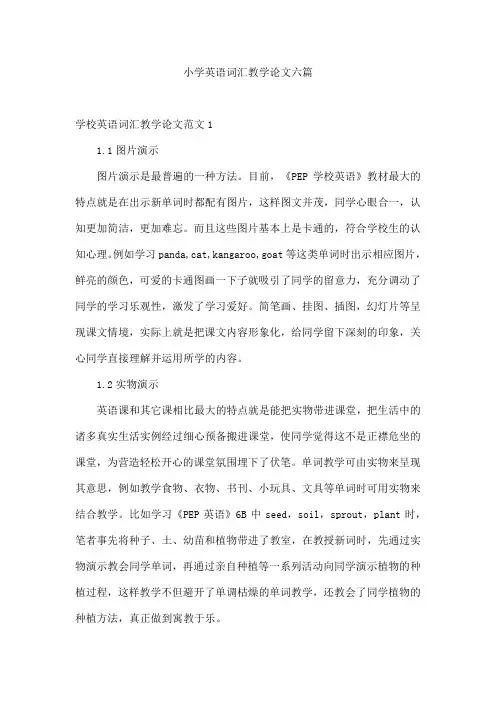
小学英语词汇教学论文六篇学校英语词汇教学论文范文11.1图片演示图片演示是最普遍的一种方法。
目前,《PEP学校英语》教材最大的特点就是在出示新单词时都配有图片,这样图文并茂,同学心眼合一,认知更加简洁,更加难忘。
而且这些图片基本上是卡通的,符合学校生的认知心理。
例如学习panda,cat,kangaroo,goat等这类单词时出示相应图片,鲜亮的颜色,可爱的卡通图画一下子就吸引了同学的留意力,充分调动了同学的学习乐观性,激发了学习爱好。
简笔画、挂图、插图,幻灯片等呈现课文情境,实际上就是把课文内容形象化,给同学留下深刻的印象,关心同学直接理解并运用所学的内容。
1.2实物演示英语课和其它课相比最大的特点就是能把实物带进课堂,把生活中的诸多真实生活实例经过细心预备搬进课堂,使同学觉得这不是正襟危坐的课堂,为营造轻松开心的课堂氛围埋下了伏笔。
单词教学可由实物来呈现其意思,例如教学食物、衣物、书刊、小玩具、文具等单词时可用实物来结合教学。
比如学习《PEP英语》6B中seed,soil,sprout,plant时,笔者事先将种子、土、幼苗和植物带进了教室,在教授新词时,先通过实物演示教会同学单词,再通过亲自种植等一系列活动向同学演示植物的种植过程,这样教学不但避开了单调枯燥的单词教学,还教会了同学植物的种植方法,真正做到寓教于乐。
2归类记忆法归类记忆法是将分散、零星的一些单词按不同类别划为一组进行系统记忆的方法,特别适合六班级同学在总复习阶段学习单词时运用。
例如:表示水果的单词apple,banana,pear,pineapple,lemon,strawberry,peach,mango等;表示食物类的单词:dumpling,sandwich,hamburger,bread,rice,milk等;表示交通工具的单词:car,bus,plane,sled,ship,subway,bike等。
这种方法使用很普遍,学校阶段大部分所学单词都可以像这样按类别进行归纳,如:方向,文具,生活用品,家庭成员,天气,颜色,时间,运动,人体各部位等。
![英语词汇学的论文怎么写[共5篇]](https://uimg.taocdn.com/6ecb7b3191c69ec3d5bbfd0a79563c1ec5dad7fa.webp)
英语词汇学的论文怎么写[共5篇]第一篇:英语词汇学的论文怎么写英语词汇学的论文怎么写?英语词汇学习在英语词汇学习过程中,学习者要遵循第二语言习得的规律,掌握并灵活运用多种词汇学习策略。
可分为词汇表策略、语境策略、精加工策略、语义场策略。
一.词汇表策略(Word list strategy)词汇表策略一般为:一列是按字母顺序排列的英语单词,另一列是这些单词的汉语意思(等值词、同义词或近义词)。
有些学者认为,通过词汇表策略能够迅速且有效地学会大量的词汇。
然而,Gaims 和Redman 却指出,通过词汇表记忆词汇会阻碍对所记词汇进行充分地处理和系统地组织,因此就失去了有效的长时记忆的基础。
语言大师桂诗春教授也认为,词汇表策略既费时又费力,徒劳无功,因为这种做法不仅把外语的词语和母语的词语等同起来,而且把它从语言和语境中孤立出来。
二.语境策略(Context strategy)语境策略就是学习者通过上下文语言环境所提供的信息对出现在语境中的生词进行猜测,从而习得这个单词。
语境策略是目前比较流行的词汇学习策略之一,它不仅仅可以扩大词汇量,而且可以让学生了解有关目的语的文化知识。
但是,Channell(Carter &McCarthy ,1988:89)认为,音节认知和重音认知对学习者理解词汇起着非常重要的作用。
为了更好地理解词汇,学习新单词的方法应使学习者准确地内化和吸收新单词:即学会单个音标的发音、了解音节数、掌握重音位置。
从这一方面来看,运用语境策略学习词汇不能算是一个很好的方法。
三.精加工策略(Elaborative strategy)精加工策略是指通过对学习材料进行深入细致的分析、加工,理解其内在的深层意义并促进记忆的一种策略。
皮连生(1998)在《学与教的心理学》一书中也曾提到:“精细加工策略”(同“精加工策略”)指对学习材料作精细的加工活动,即通过在要记忆的材料上增加相关的信息来达到对新的材料记忆的学习方法。
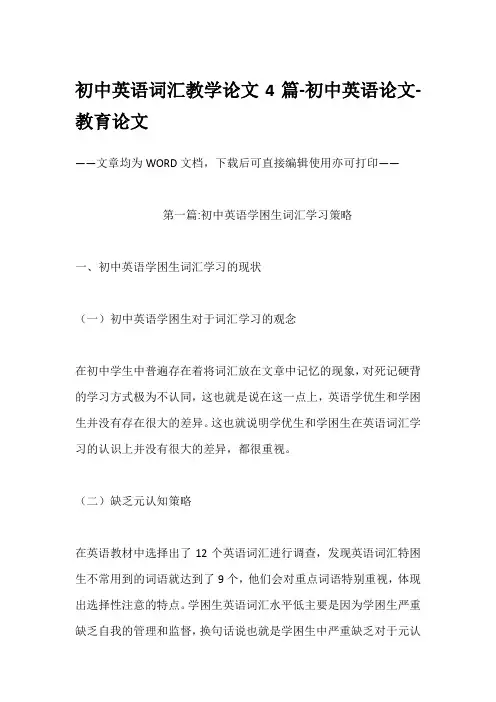
初中英语词汇教学论文4篇-初中英语论文-教育论文——文章均为WORD文档,下载后可直接编辑使用亦可打印——第一篇:初中英语学困生词汇学习策略一、初中英语学困生词汇学习的现状(一)初中英语学困生对于词汇学习的观念在初中学生中普遍存在着将词汇放在文章中记忆的现象,对死记硬背的学习方式极为不认同,这也就是说在这一点上,英语学优生和学困生并没有存在很大的差异。
这也就说明学优生和学困生在英语词汇学习的认识上并没有很大的差异,都很重视。
(二)缺乏元认知策略在英语教材中选择出了12个英语词汇进行调查,发现英语词汇特困生不常用到的词语就达到了9个,他们会对重点词语特别重视,体现出选择性注意的特点。
学困生英语词汇水平低主要是因为学困生严重缺乏自我的管理和监督,换句话说也就是学困生中严重缺乏对于元认知策略的认识,并不会对英语词汇进行反复的回顾和体会。
(三)缺少认知策略在初中生中对于英语的学习最普遍的是进行反复的练习,以求能够熟练掌握住英语词汇的用法;在英语学习的过程中,还普遍存在着联系上下文学习的方法和死记硬背的方法,也有不少的学生使用查字典的方法进行学习,这就与学优生之间存在较大的区别了,学优生普遍是通过进行阅读大量的英语文章,来提高自己的英语词汇量和词汇应用水平,在此基础上再进行大量的练习,会达到事半功倍的效果。
二、提高初中英语学困生词汇学习水平的策略(一)对英语学困生的自我反思和调控能力进行培养在学困生进行英语学习的过程中,要注意对学困生的反思能力进行培养以提高学生进行问题思考的能力,并对英语词汇进行描述,以加快学困生对于英语单词的理解力。
反思是在大脑中形成一种思维的方式,对问题采取较为严谨的态度,属于解决问题时的特殊方式。
在培养学困生自我控制能力的过程中,需要先提高学困生的英语学习积极性和兴趣,只有这样才能提高英语学习的有效性,老师在日常教学活动中,要注意观察学生所感兴趣的事情,并将其充分的应用到初中英语的教学中。
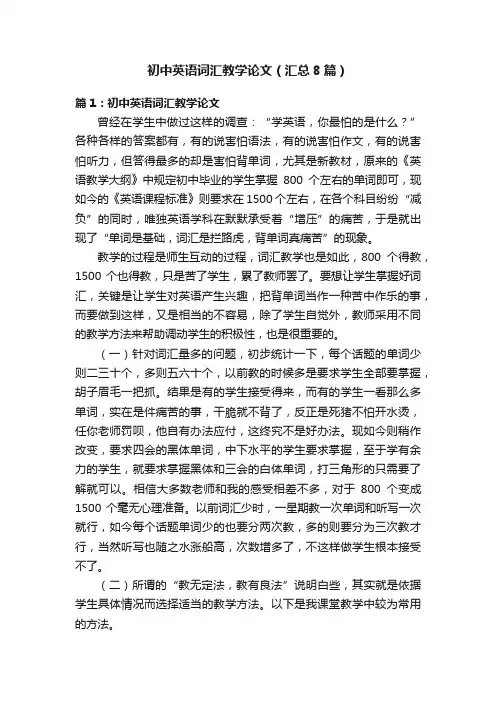
初中英语词汇教学论文(汇总8篇)篇1:初中英语词汇教学论文曾经在学生中做过这样的调查:“学英语,你最怕的是什么?”各种各样的答案都有,有的说害怕语法,有的说害怕作文,有的说害怕听力,但答得最多的却是害怕背单词,尤其是新教材,原来的《英语教学大纲》中规定初中毕业的学生掌握800个左右的单词即可,现如今的《英语课程标准》则要求在1500个左右,在各个科目纷纷“减负”的同时,唯独英语学科在默默承受着“增压”的痛苦,于是就出现了“单词是基础,词汇是拦路虎,背单词真痛苦”的现象。
教学的过程是师生互动的过程,词汇教学也是如此,800个得教,1500个也得教,只是苦了学生,累了教师罢了。
要想让学生掌握好词汇,关键是让学生对英语产生兴趣,把背单词当作一种苦中作乐的事,而要做到这样,又是相当的不容易,除了学生自觉外,教师采用不同的教学方法来帮助调动学生的积极性,也是很重要的。
(一)针对词汇量多的问题,初步统计一下,每个话题的单词少则二三十个,多则五六十个,以前教的时候多是要求学生全部要掌握,胡子眉毛一把抓。
结果是有的学生接受得来,而有的学生一看那么多单词,实在是件痛苦的事,干脆就不背了,反正是死猪不怕开水烫,任你老师罚呗,他自有办法应付,这终究不是好办法。
现如今则稍作改变,要求四会的黑体单词,中下水平的学生要求掌握,至于学有余力的学生,就要求掌握黑体和三会的白体单词,打三角形的只需要了解就可以。
相信大多数老师和我的感受相差不多,对于800个变成1500个毫无心理准备。
以前词汇少时,一星期教一次单词和听写一次就行,如今每个话题单词少的也要分两次教,多的则要分为三次教才行,当然听写也随之水涨船高,次数增多了,不这样做学生根本接受不了。
(二)所谓的“教无定法,教有良法”说明白些,其实就是依据学生具体情况而选择适当的教学方法。
以下是我课堂教学中较为常用的方法。
1音标教学法:七年级英语刚入门时,教师在字母教学法中应该融入音标教学,可以要求学生学会制作音标卡,并要求他们背诵48个国际音素。
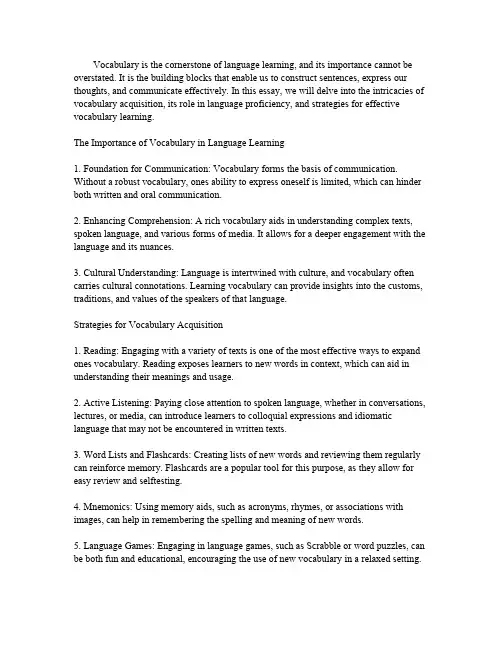
Vocabulary is the cornerstone of language learning,and its importance cannot be overstated.It is the building blocks that enable us to construct sentences,express our thoughts,and communicate effectively.In this essay,we will delve into the intricacies of vocabulary acquisition,its role in language proficiency,and strategies for effective vocabulary learning.The Importance of Vocabulary in Language Learning1.Foundation for Communication:Vocabulary forms the basis of communication. Without a robust vocabulary,ones ability to express oneself is limited,which can hinder both written and oral communication.2.Enhancing Comprehension:A rich vocabulary aids in understanding complex texts, spoken language,and various forms of media.It allows for a deeper engagement with the language and its nuances.3.Cultural Understanding:Language is intertwined with culture,and vocabulary often carries cultural connotations.Learning vocabulary can provide insights into the customs, traditions,and values of the speakers of that language.Strategies for Vocabulary Acquisition1.Reading:Engaging with a variety of texts is one of the most effective ways to expand ones vocabulary.Reading exposes learners to new words in context,which can aid in understanding their meanings and usage.2.Active Listening:Paying close attention to spoken language,whether in conversations, lectures,or media,can introduce learners to colloquial expressions and idiomatic language that may not be encountered in written texts.3.Word Lists and Flashcards:Creating lists of new words and reviewing them regularly can reinforce memory.Flashcards are a popular tool for this purpose,as they allow for easy review and selftesting.4.Mnemonics:Using memory aids,such as acronyms,rhymes,or associations with images,can help in remembering the spelling and meaning of new words.nguage Games:Engaging in language games,such as Scrabble or word puzzles,can be both fun and educational,encouraging the use of new vocabulary in a relaxed setting.6.Consistent Practice:Regularly using new vocabulary in speaking and writing is crucial for retention.Practice makes permanent,and the more frequently a word is used,the more likely it is to become a permanent part of ones vocabulary.7.Contextual Learning:Understanding the context in which a word is used can greatly enhance its memorability.Learning words in phrases or sentences rather than in isolation can provide a clearer understanding of their meaning and usage.8.Cultural Immersion:Immersing oneself in the culture where the language is spoken can provide a wealth of opportunities to learn new vocabulary organically.This can be through travel,language exchange programs,or engaging with native speakers in ones community.ConclusionVocabulary is not just a collection of words it is a key to unlocking the full potential of language learning.By employing a variety of strategies and maintaining a consistent approach to vocabulary acquisition,learners can significantly enhance their language proficiency and cultural understanding.It is through the mastery of vocabulary that one can truly become fluent and expressive in a new language.。
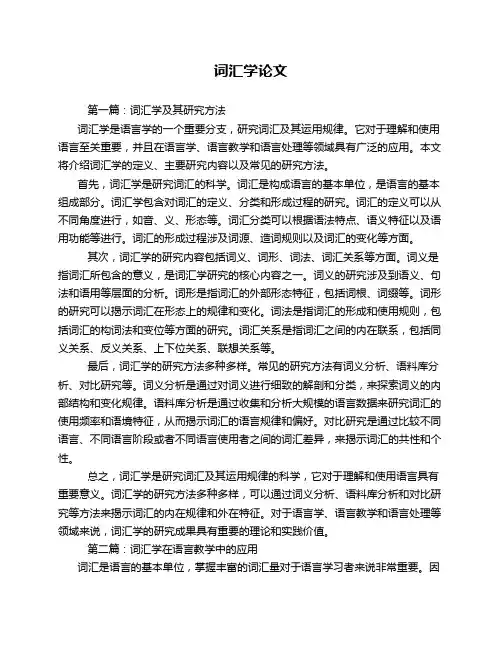
词汇学论文第一篇:词汇学及其研究方法词汇学是语言学的一个重要分支,研究词汇及其运用规律。
它对于理解和使用语言至关重要,并且在语言学、语言教学和语言处理等领域具有广泛的应用。
本文将介绍词汇学的定义、主要研究内容以及常见的研究方法。
首先,词汇学是研究词汇的科学。
词汇是构成语言的基本单位,是语言的基本组成部分。
词汇学包含对词汇的定义、分类和形成过程的研究。
词汇的定义可以从不同角度进行,如音、义、形态等。
词汇分类可以根据语法特点、语义特征以及语用功能等进行。
词汇的形成过程涉及词源、造词规则以及词汇的变化等方面。
其次,词汇学的研究内容包括词义、词形、词法、词汇关系等方面。
词义是指词汇所包含的意义,是词汇学研究的核心内容之一。
词义的研究涉及到语义、句法和语用等层面的分析。
词形是指词汇的外部形态特征,包括词根、词缀等。
词形的研究可以揭示词汇在形态上的规律和变化。
词法是指词汇的形成和使用规则,包括词汇的构词法和变位等方面的研究。
词汇关系是指词汇之间的内在联系,包括同义关系、反义关系、上下位关系、联想关系等。
最后,词汇学的研究方法多种多样。
常见的研究方法有词义分析、语料库分析、对比研究等。
词义分析是通过对词义进行细致的解剖和分类,来探索词义的内部结构和变化规律。
语料库分析是通过收集和分析大规模的语言数据来研究词汇的使用频率和语境特征,从而揭示词汇的语言规律和偏好。
对比研究是通过比较不同语言、不同语言阶段或者不同语言使用者之间的词汇差异,来揭示词汇的共性和个性。
总之,词汇学是研究词汇及其运用规律的科学,它对于理解和使用语言具有重要意义。
词汇学的研究方法多种多样,可以通过词义分析、语料库分析和对比研究等方法来揭示词汇的内在规律和外在特征。
对于语言学、语言教学和语言处理等领域来说,词汇学的研究成果具有重要的理论和实践价值。
第二篇:词汇学在语言教学中的应用词汇是语言的基本单位,掌握丰富的词汇量对于语言学习者来说非常重要。
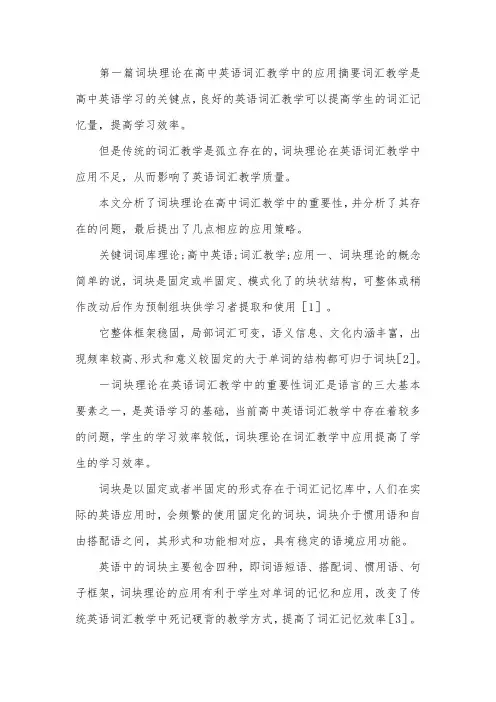
第一篇词块理论在高中英语词汇教学中的应用摘要词汇教学是高中英语学习的关键点,良好的英语词汇教学可以提高学生的词汇记忆量,提高学习效率。
但是传统的词汇教学是孤立存在的,词块理论在英语词汇教学中应用不足,从而影响了英语词汇教学质量。
本文分析了词块理论在高中词汇教学中的重要性,并分析了其存在的问题,最后提出了几点相应的应用策略。
关键词词库理论;高中英语;词汇教学;应用一、词块理论的概念简单的说,词块是固定或半固定、模式化了的块状结构,可整体或稍作改动后作为预制组块供学习者提取和使用[1]。
它整体框架稳固,局部词汇可变,语义信息、文化内涵丰富,出现频率较高、形式和意义较固定的大于单词的结构都可归于词块[2]。
一词块理论在英语词汇教学中的重要性词汇是语言的三大基本要素之一,是英语学习的基础,当前高中英语词汇教学中存在着较多的问题,学生的学习效率较低,词块理论在词汇教学中应用提高了学生的学习效率。
词块是以固定或者半固定的形式存在于词汇记忆库中,人们在实际的英语应用时,会频繁的使用固定化的词块,词块介于惯用语和自由搭配语之间,其形式和功能相对应,具有稳定的语境应用功能。
英语中的词块主要包含四种,即词语短语、搭配词、惯用语、句子框架,词块理论的应用有利于学生对单词的记忆和应用,改变了传统英语词汇教学中死记硬背的教学方式,提高了词汇记忆效率[3]。
其次,词块理论应用培养了学生的英语思维能力,通过对词块的记忆,学生可以轻松驾驭英语词汇,在潜移默化中树立良好的英语思维,对英语文化也有深刻的理解,从而提高了英语应用能力。
再者,可以提高学生的听说读写能力,高中英语学习的关键在于培养学生的听说读写四大能力,学生在学习过程中建立词块意识,在大脑中形成了词块固定搭配,从而大大缩短了听者对说者意思的理解能力和正确率。
二、高中英语词汇教学中存在的问题当前在高中英语词汇教学中存在着学习效率较低,词汇记忆反复性较强的现象,从而严重影响了学生的英语水平,不利于学生英语思维的培养,下面针对词汇教学中存在的问题进行详细分析一词块理论教学方法不当在高中阶段的学习中,词汇学习主要依赖于教师的课堂讲解,传统的教学方式是教师领读词汇,并给出词汇的释义和应用语境,介绍相关的词组,学生只是被动性的记忆,其词汇学习仅仅停留在表层认识上,忽视了对词块理论的内涵理解,从而造成学生在应用英语词汇时出现错误频频。
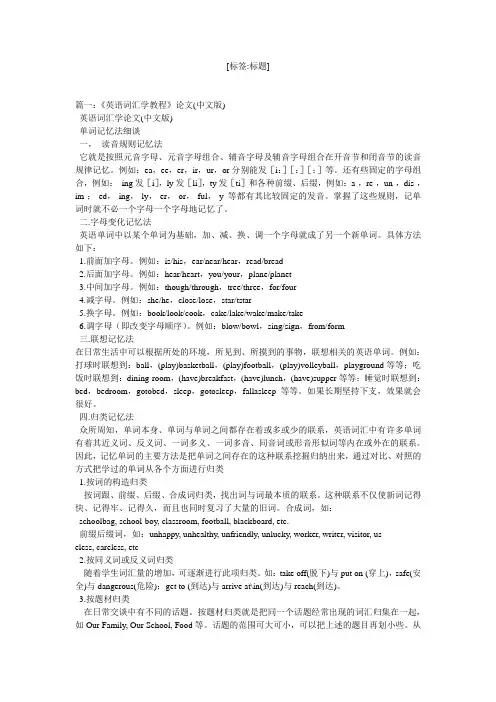
[标签:标题]篇一:《英语词汇学教程》论文(中文版)英语词汇学论文(中文版)单词记忆法细谈一,读音规则记忆法它就是按照元音字母、元音字母组合、辅音字母及辅音字母组合在开音节和闭音节的读音规律记忆。
例如:ea,ee,er,ir,ur,or分别能发[i:][:][:]等。
还有些固定的字母组合,例如:ing发[i],ly发[li],ty发[ti]和各种前缀、后缀,例如:a-,re-,un-,dis-,im-;-ed,-ing,-ly,-er,-or,-ful,-y等都有其比较固定的发音。
掌握了这些规则,记单词时就不必一个字母一个字母地记忆了。
二.字母变化记忆法英语单词中以某个单词为基础,加、减、换、调一个字母就成了另一个新单词。
具体方法如下:1.前面加字母。
例如:is/his,ear/near/hear,read/bread2.后面加字母。
例如:hear/heart,you/your,plane/planet3.中间加字母。
例如:though/through,tree/three,for/four4.减字母。
例如:she/he,close/lose,star/tstar5.换字母。
例如:book/look/cook,cake/lake/wake/make/take6.调字母(即改变字母顺序)。
例如:blow/bowl,sing/sign,from/form三.联想记忆法在日常生活中可以根据所处的环境,所见到、所摸到的事物,联想相关的英语单词。
例如:打球时联想到:ball,(play)basketball,(play)football,(play)volleyball,playground等等;吃饭时联想到:dining-room,(have)breakfast,(have)lunch,(have)supper等等;睡觉时联想到:bed,bedroom,gotobed,sleep,gotosleep,fallasleep等等。
一。
The Development of English VocabularyThere are about one million English words in all. English is also an international language in this society. You can see English words almost every where, even in non-English-spoken countries.How does English come into being? Why it has so many vocabularies? In the following passage, I will give you a general picture about these two questions. The English people are of a mixed blood. The early inhabitants of the island we now call England were Britons, but in fact all the races were the invaders came from Europe. Nobody knows very much about Britain before the Romans came during the first century BC, but there had been at least three invasions before that. The first of these was by a dark-haired Mediterranean race called the Iberians. The other two were by Celtic tribes: one is Gaels, whose descendants are the modern Scots and Irish; another is the Britons, who gave their name to the whole island of Britain. These were the people whom the Romans conquered. The Romans gave the Britons a good deal of their civilization. Then at the beginning of the fifth century Britain was invaded by three tribes from the northern Europe: the Angles, the Saxons, and the Jutes. These three tribes merged into one people, and the three dialects they spoke naturally grew into a single language, the English language.But at first, the English word made up of only a small part of native words and some borrowed words. The native words were the core words of English. According to a kind of classification of language, English is classified as a Teutonic language, which is a Germanic language. To be more exact, English belongs to the low West Germanic branch of the Indo-European family. Because of the complex history of Briton, the language of English is of a mixed character. On one hand, it shares with West Germanic languages many common words and similar grammatical structures. On the other hand, more than half of the English vocabulary is derived from Latin and French. Besides, English has accepted words from other languages of the world in the course of its historical development.The history of English language is divided into three periods:1. the old English period ( from 450AD to 1150 AD )2. the middle English period ( from 1150AD to 1500AD )3. the modern English period ( from 1500AD up to now )As I mentioned above, in fact, that there is also a period we can call it thepre-old English period, which includes the Celts, the Scottish and Irish races and culture, and also Welsh race and culture were brought by the Celts. Then the Romans brought Latin alphabet and civilization to this land. After these two were the formation of the Anglo-Saxons people, which is the original English race and language.Old English consists mainly about the native language of Anglo-Saxons people. The period from 450AD to 1150AD is known as the old English period, and it isalso been called Anglo-Saxons period. It is described as the period of full inflections, since during most of this period the case endings of the noun, the adjective, and the conjugation of the verb were not weakened. Also during this period, when the Norman Conquest in 1066AD brought French to England, and much of the English vocabulary was replaced by words borrowed from French and Latin.Old English is a synthetic language. (There are two classes of languages in the world: synthetic and analytic. A synthetic language is one which shows the relation of words in a sentence largely by means of inflections. An analytic language is one which indicates the relation of words in a sentence by means of word order, prepositions or auxiliary verbs, rather than by inflections.) Old English nouns and adjectives have four cases: the nominative case, the genitive case, the dative case and the accusative case. Apart from these four cases, Latin nouns have the ablative and locative cases.Middle English period is from 1150AD to 1500AD. During this period the inflections which had begun to break down towards the end of the old English period, became greatly reduced, and it is known as the period of leveled inflections. The Norman Conquer was the cause of this change. The change of this period had a great effect on both grammar and vocabulary. In grammar English has changed from a highly inflected language to an analytic language. In this period many old English words were lost, but thousands of words borrowed from French and Latin appeared in the English vocabulary. French influence on the English vocabulary is much more direct and observable. The number of French words that came into English was very numerous. More than half of the English vocabulary is derived from Latin.Modern English period is from 1500 to the present. A large part of the original inflectional system has disappeared, and it is known as the period of lost inflections. We may divide this period into two parts: the early Modern English period and the Late Modern English period.The early modern English period extends from 1500AD to 1700AD. The chief influence of this time was the great humanistic movement of the Renaissance. In this period the study of the Latin and Greek classics was stressed, so the influence of Latin and Greek on English was great.The late modern English period started after 1700AD. The eighteenth century in England was a time of stabilizing and purifying the English language. The publication in 1755AD of A Dictionary of the English Language edited by Samuel Johnson was a typical example of consolidating and purifying the English language in this period. He set a standard for using English words in spelling, meaning and usage. In the eighteenth century French greatly influenced English. The number of French words in the period from 1650AD to 1800AD increased rapidly. Such as: ballet, cartoon, champagne, cohesion, dentist, patrol, publicity, routing, etc.Meanwhile the territorial expansion of the English empire in this period resulted in the expansion of the English vocabulary. Thus, there are many words flow into English vocabulary, which includes American Indian words, Mexican words, Peru words, Brazil words, India and African words.The nineteenth and twentieth centuries are a period of rapid expansion for the English vocabulary in the history of the English language. In this period many changes have taken place. Especially the great development of science and technology is reflected in the English vocabulary.Besides, the great changes in industry, in political and social lives, in sports and amusements all have contributed a great deal to the English vocabulary. Since the Second World War the English vocabulary has been affected powerfully by social, political, economic, especially scientific and technical changes. The English vocabulary not only changes, but also changes quickly in this period. Thousands of new words are added, existing words acquire new meaning and old words die out.Till now, the English vocabulary is still changing, some words come out and some die out. In a word, as society is constantly in a state of development, so is language. Society depends on language for its existence. As society develops new objects are created that require the invention of new words and expressions. Therefore, the changing of English vocabulary is an endless changing process.Bibliography:陆国强,published in 1999,Modern English Lexicology (new edition)Adams, Valerie, published in1982,An Introduction to Modern English Word-formation戴炜栋,published in 2002,A New Concise Course on Linguistics for Students of English朱永涛,published in 1997,The Society and Culture of Major English-speaking Countries林承璋,published in 1987,An Introduction to English Lexicology也可以写广告中的词汇特点:The Lexical Features of Advertisement on NewspaperNewspapers are generally the cheapest way to reach a mess audiences,and the timing is fast.Adverments make an important part on English Newspaper.We live in a world of advertising.Advertising provides a valuable service to society and its members,because it defines for consumers the meaning and the role of products,services and institutions.Newspaper advertisements’ main text use words for the spread of vector,and must must be simple eye-catching,because of the layout of resources.To some extent,thenewspaper advertisements content mainly rely on language toexpress.Advertising language ,playing a role of communication and persuasion,has developed its own features.Naturally,advertisements in English have become an important means of communicatingideas,demoinstrating a variety of linguistic features of its own.The present study discusses some lexical features of English advertisement texts.ⅠChoose the simple wordsAdvertiment language must be easily understood terms so that readers can get information as soon as possible.In advertising,simple words can win the consumers by their exact,effective expression an d a kind of closeness.E.g.①Take time.Any time.Continuous using two “time” can make the language simple and clear.②Once tasted,always loved.The article should be clearly and concisly understood in order to arouse the interest of customers on food which make them mouth-watering.③My goodness!My Guinness!Common language facilitate people to memory and speak,this reproduce the scene of people driking the Guinness beer which is full of praise.ⅡFrequent Employment of Simple VerbsSimple verbs are frequently employed in English advertisements, which is an obvious wording characteristics of English advertising texts.Verbs are the most important part of language.It is a prominent feature in adervertising english that verbs are regularly used for the ultimate goal of advertising ,which is to enable consumers to buy their goods.So in terms of the using of words,dynamic and strong word will produce a better feeling effects.Verbs can be used to “touch”the consumer's heart.In this way,they will have impules to buy the goods.E.g.①Drink Coca-Cola.②I want you to sponsor a Rice Paddy Baby.③For incredible speed and accuracy, try the Minolta 7000, the world’s first body-integral auto-focus SLR.In the above examples, “try”,”sponsor” and “drink”are to fulfill the “get action” requirement seem more euphemistic and even more attractive.④Get noticed. Get results.⑤Feel the Hyatt Touch.⑥Send today for your free sample, and try the new flavor.After reading the above ads, we feel encouraged to take buying action or make repeated purchases. The active voice doesn’t force people to take the passive action while it makes people feel that they do something of their own accord. Ⅲ. Adjectives⑴It is hard for us to think of any really persuasive message without the use of descriptive and vivid adjectives. Copywriters like to use a large number of adjectives not only to describe the quality and features of the products or services, but to a great extent to praise and beautify them.E.g.For people who care about their bodies, Dairy Farm brings fresh skimmed milk. With almost no fat, it keeps your body fit inside and outside, fresh skimmed milk. Fresh Dairy Farm.The adjective “fresh” in Example appears three times to emphasize how fresh the product is, making its quality particularly attra ctive. And the adjective “fit” points out the remarkable function of the product.⑵The copywriter tends to select the superlative or comparative forms of adjectives that carry positive meanings so as to make a comparison and stress the wonderful qualities of the advertised product. E.g.①Using Dove, I do feel 20 years younger.“Younger” just emphasizes the magic power of the product.②Discover the season’s newest splendor.The word “newest” , which is an advertisement of a kind of perfume, means “fashionable to the highest degree”.Of course, the advertisers must make sure that the advertised goods or services are actually the best in the same category.Sometimes people do not know how superb the goods or the services are in quality. Anyhow, people tend to believe what is said in advertisements.Ⅳ.New Words Constantly AppearIn order to attract people’s attention, copywriters like to create some new words which are more active. The new words are mainly used for truthfulness, humor or emphasis in English advertising texts. E.g.①Surefit Shoe Ltd.“Surefit” is a new word which makes consurms thing of a sentence”Surely to fit your feet”.That means the shoes are fot for your feet.②Give a Timex to all, and to all a good time.The well-known watch brand “Timex” is a variation of “Time + Excellent”, wh ich persuasively shows the merit of the watch brand. Thus, brand names get and retain a unique image.Ⅴ.PronousPronouns of the first and second person: we, I and you outnumber the other pronouns in advertisements. It is because that you, we and I help create a friend-like intimate atmosphere to move and persuade the audience. The audience will easily accept a product, a service or an idea as if a good friend recommended them.Sometimes,we use infinitive pronouns,such asall,everyone,none,nothing and so on in order to feflect the extraordinarycharacteristics of a particular commodity or it has been spending and receiving most of people.E.g.Our finest time.It is about a well-known red wine.A pair of lover drink together at romantic atmosphere.Ⅵ.Compound wordsA compound word is often a noun or an adjective made up of two or more words which are frequently used to express more information in limited space. Especially,compound adjectives are often seen in advertisements.E.g.Kodak Single-use-came ras take pictures where you wouldn’t normally take your camera.It used the compound word skillfully and describe the capability and function of the product incisively and vividly.Now we have briefly discussed the six wording characteristics of English advertisements. We have got to know that simple verbs and concise adjectives are very important words in English advertising, and that new words which are attractively used to stress the new and special qualities or functions of the advertised products. Language in advertising presents us with a colorful, interesting and wonderful world in order to serve the purpose of attracting advertising readers. Of course, besides the above features discussed in this study, there is much more for further study in advertising language.Email:********************。
On native words and borrowings in the English vocabulary AbstractAs time goes on, great changes have taken place in native English vocabulary. In addition to the inner evolvement of itself, it has also absorbed more and more borrowings from other culture. This essay will focus on exactly this subject. The main parts in this paper are: ①to exhibit the basic conceptions regarding native words and borrowings in English vocabulary;②to discuss the major features of English native words;③to discuss the major sources and features of borrowings in the English vocabulary; ④to explore the interrelation between the native and foreign elements in the English vocabulary.⑤to make a conclusion of the whole paper.Key words native words borrowings English vocabularyChapter 1 Basic Information about Native Words in English Vocabulary1、1 Definition of Native WordsWe should first make clear the exact definition of native words or borrowings no matter what we are going to discuss about them next.According to some dictionaries and books of lexicology, native words refer to words which originated in the region where it is used. To put it simple, native words are words that are not foreign or imported.Specifically, as for English vocabulary, native words are words brought to Britain in the fifth century by the Germanic tribes, namely the angles, the Saxons, and the jutes, thus known as Anglo-Saxon words. Though words of Anglo-Saxon origin are small in number, they stand at the core of the language.1、2 Features of native wordsGenerally speaking, native words have these features below:First, they are neutral in style. That is to say, native words are usually neither formal nor informal. This is because native words denote the commonest things in human society. Almost all the people use them in all places, on all occasions, and at all times. Take the word begin and commerce for instance. Begin is a typical native word and commerce is a borrowing.Obviously, we use begin neither formally or informally. However we use commerce mostly in formal occasions.Second, they are frequent in use. Native words are the foudation and the core of the English vocabulary. Native words are most frequently used in everyday speech and writing. The percentage of native words in use reaches usually as high as 70 to 90 percent.Third, in structure they are mostly monosyllabic words.Fourth, in meaning they express the fundamental concepts dealing with everyday objects and things. At the same time, they are highly polysemic words, that is, they have many meanings.Fifth, in grammar they include most parts of speech.Sixth, they are of collocability. Many commonly-used expressions and phrases in English are made up of native words.Seventh, they are good at forming word in modern English. Native words in modern English can form a great number of derivatives. For example, watery and waterless are both the derivatives of water. Native words in modern English can also form many compounds. For example, the word fire can form many compounds, such as fireman, firefighter, fireplace and firebrand and so on.Chapter 2 Basic Information about Borrowings in English Vocabulary2.1 Definition and Main Features of BorrowingsBorrowings, or borrowed words, or loan words, refers to the words taken from foreign language.As a language which owns the most speakers, English has adopted words from almost all other major languages in the world. As is stated in Encyclopedia Americana, “the English language has vast debts. In any dictionary some 80% of the entries are borrowed”. Thus the English language is called “a heavy borrower”. Here “borrowing” is not real “borrowing”. It has nothing to with returning. It’s merely a metaphor stands for the foreign words from a different culture. But not all foreign words do become borrowings. If they fall out of use before they become widespread, they do not reach the borrowing stage.Through analyzing the borrowings in English vocabulary, we can find some common features among them.First, borrowings in English vocabulary usually do not have relative native words with the same meaning with them. When this is the case, certain concepts, ideas or objects of the “lending”language community are new to the people of the “borrowing” language community. So instead of making up a complete whole new word for the idea or object they simply borrow the word from the people they came in contact with.Second, borrowings are usually words that refer to exotic ideas, concepts or objects. An example of this is how names of animals that do not inherently come from Great Britain are often loanwords in English. The name of the animal is borrowed from the language that is spoken in the country in which the animal originally comes from or lives in.Third, most of the borrowings in English vocabulary are nouns. Nouns and lexical words in general, are borrowed more frequently than grammatical words. An example of this is the word “bagel”. The word was adopted from the Yiddish language, since the Jews were those who introduced bagels to the rest of the world. Many other languages, including English, therefore borrowed the word “bagel”.Fourth, borrowings are often even more widely known than native words since their borrowing served a certain purpose, for example to provide a name for a new invention. An example of such a borrowing is “pizza”. Since the Italians were those who introduce pizzas in England, the England borrowed the word from them.2.2 Major Sources of Borrowings in the English VocabularyTo discuss this question, we should first get to know the exact meaning of “source of borrowing”. Here it refers to the place where the borrowing was borrowed.Generally speaking, Latin, Greek and French are the three languages that have contributed most to the English language. Other foreign languages that have contributed words are of less importance.That is to say, Latin, Greek and French are the three main sources where borrowings in English vocanulary come from. Apart from the three, Scandinavian, Celtic, Dutch, Low German, Arabic, Persian, Portuguese, Spanish are also the main sources of borrowings in English vocabulary. Some examples of borrowings in English voabulary are as follows.Among those borrowings that come from the Germanic are the words father, mother, brother, man, wife, tree, grass, summer, winter, bring, come, get, hear, meet, and think and so on.Such words as constitution, president, parliament, congress, city, place, , diner, café, liberty, veracity, carpenter, draper, haberdasher, mason, painter, plumber, and tailor are from France.English has acquired many words from Spanish. Some of these have been borrowed directly: cigar, armada, guerrilla, matador, mosquito, and tornado.Borrowings from Latin have been especially numerous. Many of these represent combinations of Latin words: alnutrition, transfer, circumference, supernatural, submarine, suburb, substantial, contemporary, multilingual, conjunction, compassion, and hundreds more.Borrowings from Greek are heavy in the sciences and technology. In addition to macro and micro, often-used prefixes include poly and tele. Among the well-known English words from Greek are alphabet, geometry, geology, photography, psychology, pathology, biology, philosophy, telephone, logistics, and metamorphosis.Among the common English words that have come from Arabic are: alcohol, alchemy, algebra, alkali, almanac, arsenal, assassin, cipher, elixir, mosque, naphtha, sugar, syrup, zenith, and zero.Borrowings in English vocabulary are so numerous that they can not be listed one by one The above are the language sources that English vocabulary comes from. Below are the specific sources or we’d better say specific channels that borrowings come from. Generally speaking, English vocabulary mainly comes through conquest, commerce, travel, literature, mass media or some other ways. In other words, those borrowings have come into English vocabulary through the spoken word, on one hand, and through the written word, on the other hand.Chapter 3 The Interrelation between the Native and Foreign Elements in the English VocabularyIn fact, no language has so complex and varied a vocabulary as English. The English vocabulary has been adopted from more than fifty languages. As a cosmopolitan language English has no rival. That is to say, up to seventy percent of the English vocabulary consists of loan-words, and only thirty percent are native words.In spite of large-scale borrowings, it is the native words that form the basic stock of modern English vocabulary. And what’s more, native words are used in everyday speech and writing more frequently than borrowed words.Generally, the longer a borrowed word has been in the language, and the more frequently it is used, the more it resembles the native words of the language.In the course of historical development borrowed words have extended the total number of the English vocabulary, and Latin or Greek roots, prefixes or suffixes have changed the structures of English words.Chapter 4 conclusionTo sum up, we can say that English vocabulary has been marked by the word ‘borrowing’. Since early times, English has been in contact with other languages such as Greek, French, Scandinavian, Celtic, Dutch, Low German, Arabic, Persian, Portuguese, and Spanish and so on, and as a result, English vocabulary has been riched under the influence of other languages. It is native words and borrowings together help strengthen the English vocabulary and make it a very open and the most poewrful language in the modern world.Bibliography参考书目??/~kemmer/Words04/structure/borrowed.htmlhttp://www1.ku-eichstaett.de/SLF/EngluVglSW/grzega1032.pdfhttp://dooku.miun.se/engelska/englishC/C-essay/VT06/Final/NicoleFerm.pdf/~kemmer/Words/loanwords.html/media_file/200708/huashi/0809/cihuix/web/unit02.htm。
湖北文理学院词汇学引论课程论文论文题目:词汇学的学习意义姓名学号:2011105318专业:英语院系:外国语学院目录摘要 (3)关键词 (3)引言 (3)文献回顾 (3)第一章第二外语学得与外语教学工作的关系 (3)第二章英语词汇学重要内容简述 (4)第三章词汇学在第二语言学习中的作用 (5)1、构词法在第二语言学习中的作用 (5)2、词义变化在第二语言教学中的作用 (6)3、英语成语在第二语言教学中的作用 (7)第四章结语 (8)参考书目 (8)摘要:英语词汇普遍存在,无论是诗歌,还是散文等文章都是由词汇组成的。
英语词汇它存在于生活中的每一个地方,在人类的生活中起到了至关重要的作用。
这引起了语言学家的关注,经过不停的总结与分析最终发现词汇对语言发展的积极作用。
尝试将词汇学加入到日常教学中。
关键词:英语词汇学内容作用教学引言:词汇是语言的三大要素之一,在语言学习中起着重要作用。
英国语言学家威尔斯金曾说过:“没有语法,人们表达的事物寥寥无几,而没有词汇,人们则无法表达任何事物。
”词汇在语言中占有如此重要的地位,因此对词汇教学进行研究具有重要意义。
所有英语的学习者都清楚,学好英语必须学习大量的词汇。
但面对如此多的生词时,我们时常感到困惑、烦躁,因此学会一些有用的词汇学知识,使之应用于词汇学习就显得特别重要。
本文主要从词汇学的角度,采用构词法理论和语篇中的词汇衔接理论来研究英语词汇。
本文将通过对大量词语的分析、研究来论述词汇产生的原因、背景,在此基础上并试图发现词汇发展的特点。
本文期望能具有一定的实用价值,使英语学习者对词的构成及衔接有比较清晰的认识,同时能激发英语学习者学习英语词汇的兴趣,帮助其有效扩大词汇量,灵活掌握英语词汇。
文献回顾:作为一种语法现象,英语插入语引起了众多语法学家的关注。
本文拟从四个章节研究英语词汇及词汇学习。
论文第一章主要介绍二语学得与外语教学工作的关系。
接下来第二章是英语词汇学重要内容简述。
与词汇学有关的英语作文英文回答:When it comes to vocabulary, the English language is a treasure trove of words that can express a wide range of ideas and emotions. From the most mundane to the most sophisticated, the English language has a word for it.As a native English speaker, I have always been fascinated by the sheer number and diversity of words in my language. From the simple words we learn as children, such as "cat" and "dog," to the more obscure words we might only encounter in specialized texts, such as "sesquipedalian" and "floccinaucinihilipilification," the English language has a word for every occasion.One of the things that makes the English language so rich is its complex history. Over the centuries, English has borrowed words from many other languages, including Latin, Greek, French, and German. This has resulted in alanguage that is both diverse and nuanced.For example, the word "beautiful" comes from the Latin word "bellus," which means "fair" or "handsome." The word "computer" comes from the Latin word "computare," which means "to calculate." And the word "jazz" comes from the French word "jaser," which means "to chatter."These are just a few examples of the many words thatthe English language has borrowed from other languages. Asa result of this linguistic borrowing, the English language is now one of the most expressive and versatile languagesin the world.中文回答:说到词汇,英语就是一座宝库,里面有丰富多彩的单词,能表达各种意义和情感。
英语词汇学论文-构词法1Abstract词汇是我们在英语学习过程中最大的障碍。
然而,英语构词法能够帮助我们很好的辨别并正确理解英语,同时也可以在短时间内增加我们的词汇量,英语构词法是学习英语的有效途径和强有力的“武器”,在所有的英语构词法中,词缀法能够生成的新单词是最多的也是最广泛,它被认为英语学习的最佳途径之一。
除了词缀发以外,复合法、转类法、混成法、截短法、首字母拼音法、逆向构词法也都是英语学习的有效途径Vocabulary is one of the main obstacles of English study. However English word formation can hel p us recognize English words, understand them correctly, and enlarge our vocabulary quickly. It is an efficient way and powerful weapon for English study. Among them,affixation is the strongest one to form a great range of vocabulary, and it is claimed to be one of t he best ways of learning English. Besides, compounding, conversion, blending, clipping, acronyms , back-formation are also efficient ways of learning English. In the paper the ways and characterist ics of word formation is analyzed form these aspects: affixation, compounding, conversion, blendi ng.Key words: English, lexicology, word formation, affixation (关键字:英语、词汇学,构词法,词缀法)IntroductionThe expansion of vocabulary in modern English depends chiefly on word formation. There is a var iety of means being at work now. The most productive are affixation, compounding and conversio n. Talking about word formation patterns means dealing with rules. But not all words which are p roduced by applying the rule are acceptable. The acceptability is gained only when the word have gained aninstitutional currency in the language. Therefore rules only provide a constant set of models from which new word are created from day to day. Rules themselves are not fixed but undergo change s to a certain extent. For instance, affixes and compounding processes may become productive at one time or lose their productivity. By word formation processes, we concentrate on productive or on productive rules. While applying the rules, we should keep in mind that there are always ex ceptions. In my opinion, the most important principle for all these rules of word formation is eco nomy.Chapter 1 the function of English word formation1.1 Word formation is an effective way to enlarge our English vocabulary.Nowadays, more and more people have taken notice of learning English. The number of the peop le who begin to learn English has increased at a high speed. How can we improve our English effe ctively is undoubtedly the focus of our attention. Generally speaking, vocabulary and grammatica l rules are keys to learning English2well. Among the two aspects, vocabulary apparently plays a more important role. Vocabulary is t he foundation of language. If a language learner doesn‟t haveenough vocabulary to express his or her opinions and understand other people, even if his or her grammatical rules and pronunciations are excellent, but he can not communicate with others wel l, he shouldn‟t be a good language learner.Under the influence of traditional teaching mode, teachers often emphasis more on grammatical rules and pronunciations than vocabulary. As a result, students spend a lot of time on rememberi ng new words, but the results are not so efficient. However if we have a knowledge of English wo rd formation, the results will be not that bad. Word formation is really an effective way to enlarge our English vocabulary.1.2 Word formation can help us have a better comprehension of an article.When we are reading a new article, we often encounter with some new words that we have neve r seen before. In this case, most of us will leave out the new word and go on with the following se ctions. However, this is not a good habit. If we want toimprove our English, we have to take every new word seriously either look them up in the diction ary or search for the internet. But don‟t you think that these methods are inefficient? If we know something about English word formation, maybe the article would not be so difficult for us to un derstand. In this way, we can guess the meaning of the new word according to what we have lear ned about English word formation. It has been proved that our guess is correct in most cases. So we say word formation can help us have a better comprehension of a new article.1.3 Many new words can be derived based on the rules of word formationRecent years, the use of computers as a medium of communication has given birth to a new lang uage phenomenon-cyber language. A large amount of cyber language has sprung up. Not all the new vocabulary can be recognized by human society. Some new words only emerged in a very sh ort time and then disappeared, however, there are still a lot of words are shared by many people. Finally, these words are recognized by the whole human society. Some are even added to the rev ersed dictionary. Can we say that these words are unreasonable and irrational? The answer is ab solutely “No”.Most of the new words that have been recognized are derived based on certain rules of word for mation. For example, the sentence “3QU” is widely used in the chatting room on the internet by f oreigners. This is also known as one importantcharacteristics of English word-productivity. So it is necessary for us to learn English word formati on.Chapter 2 AffixationAffixation is generally defined as the formation of words by adding word-forming or derivational affixes to bases. This process is also known as derivation, by which new words derived from old or base forms. The words that are created in this way are3called derivatives. According to the position affixes occupy in words, affixation falls into three sub categories: pre-fixation, in-fixation and suffixation.Pre-fixation is the formation of new words by adding prefixes to bases, which do not generally ch ange the word-class of the base. That is to say, prefixes do not change the part of speech of a wor d. Their chief function is to modify its meaning, although there are exceptions. In my opinion, pre fixes can be divided into: negative prefixes, pejorative prefixes, prefixes of degree or size, prefixes of time and order, and so on. Suffixation is the formation of new words by adding suffixes to base s. Their primary function is to change the grammatical function of the base, such as the change of the word class with a slight modification of meaning, though there are a few exceptions. Suffixes can be divided into noun suffixes, adjective suffixes, adverb suffixes, and verb suffixes. I can give y ou an example. The word “countless”,“-less” change the part of form and show the negative mea ning of the stem.Infixes are not so common and they usually show a kind attitude of the speaker and will not chan ge the part of form and meaning of words.Chapter 3 CompoundingCompounding is the formation of new words by joining two or more bases. Words formed in this way are called compounds. So a compound is a …lexical unit consisting of more than one base and functioning both grammatically and semantically as a single word‟ (Quirk).Compounds can be wr itten solid, hyphenated and open.Compounds have remarkable characteristics which are different from noun phrases. It comes do wn to three major ones:1) Phonological features. In compounds the word stress usually occurs on the first constituent wh ereas in noun phrases the second element is generally accented if there is only one stress. In case s where there are two stresses, the compound has the primary stress on the first element and the second stress, if any, on the second, whereas the opposite is true of free phrase.2) Semantic features. Compounds differ from free phrases semantically. Every compound should express a single idea just as one word. The meaning of a free phrase can not be inferred from the two components of itself. Nevertheless, a lot of compound are transparent, that is to say, the me aning can be obtained from theseparate elements of compounds. But the two elements are inseparable and the change of the el ement would result in the loss of the original identity.3) Grammatical features. Two elements of a compound each plays a separate grammatical role, w hich can be seen in the way the expressions are handled morphological. For example, compound nouns often show their plural forms by taking inflectional –s at the end. Though there are exceptions, their …one-wordness‟ identity is apparent.Chapter 4 Conversion4In English learning, students will often confused with words which have two or more part of form . Many of such conditions are caused by conversion. Conversion is the formation of mew words b y converting words of one part of speech to those of another part of speech, without changes in morphological structures but in function. Words created in this way are new only in a grammatica l sense. Words produced by conversion are primarily nouns, adjectives and verbs. The most produ ctive, however, is the conversion that takes place between nouns and verbs. It deserves nothing t hat conversion is not only a change of grammatical function of the item involved but with it the di fferent range of meaning is originally carried.Chapter 5 BlendingBlending is a very productive process and many coinages are resulting from blending have becom e well established. Moreover, they can sever as models for new formation. It is not the Combinati on of two words directly, but to combine parts of two words or a word plus a part of another wor d. This kind of word formation is called blending. This processes including:The first part of the first word +the last part the second word. The whole part of the first part +th e last part the second word. The first part of the first word +the first part the second word.The whole part of the second word + the first part of the first word.The overwhelming majority of blends are nouns; very few are verbs andadjectives are even fewer. Blends are mostly used in writing related to science and technology, an d newspapers and magazines. Though many of them have already achieved currency in English, t hey are still considered by the serious-minded people to be slang and informal. However, it is adv isable not to use such words too often, particularly in formal writing.ConclusionLanguage develops with the development of society and vocabulary is sensitive to the changes of society. Some old words are abandoned and some new ones are created. Most of the new words in English are created according to certain rules andconformed to certain methods. These rules and methods are closely related to English word form ation. So it is essential, as well as important, for us to learn word formation, especially for the stu dents of English major.。
英语词汇学硕士论文范文词汇教学是大学英语教学的重要组成部分,词汇教学在一定程度上影响着是大学英语教学成败。
下面是店铺为大家整理的英语词汇学论文,供大家参考。
英语词汇学论文篇一:《探讨计算机英语词汇的构词法》缩略词是计算机英语专业词汇构成的一大显著特点,使用起来方便、简洁,易于上口,而且节省书写、打印时间及文章篇幅等。
因此,缩略词在计算机英语中的应用极为普遍,作用十分活跃。
通过教学,让学生掌握常用缩略词及其含义,对学好计算机课程有很大帮助。
计算机英语缩略词主要有以下两种形式:1.首字母缩略词。
它是由词组中每个单词的第一个字母组合构成的新词。
这些词经常出现在网络、硬件描述等方面,如PC(personalcomputer)个人电脑、WWW(WorldWideWeb)万维网、BBS(BulletinBoardSystem)电子公告系统、CAI(ComputerAidedInstruction)计算机辅助教学、IT(InformationTechnol-ogy)信息技术、LAN(LocalAreaNetwork)局域网、CPU(CentralProcessingUnit)中央处理器、OS(Oper-atingSystem)操作系统、DOS(DiskOperatingSystem)磁盘操作系统、ROM(ReadOnlyMemory)只读存储器。
当然,首字母缩略只是一种大致情况,但在某些情况下,缩略词并非按照上述缩写各单词首字母的方法进行缩写,如DatabaseManagementSystem(数据库管理系统)则缩写为DBMS、HypertextTransferProtocol(超文本传输协议)缩写为HTTP。
2.截短词。
它是计算机英语中比较特殊的词,在程序设计语言的标识符和函数名、操作系统的命令、配置文件中的属性等条目中常常见到。
截短词的构成主要有两种形式:一是截取一个完整单词的前部分来代替整个单词,旨在使用起来方便快捷、简洁高效。
英语词汇学论文
词汇使我们在英语学习过程中的最大障碍,。
然而,英语构词法能够帮助我们很好的辨别并正确理解英语,同时也可以在短时间内增加我们的词汇量,就是我们学习英语的有力武器。
本学期上了词汇学,学到了一些以前学不到的东西。
总体的感觉就就是“原来英语中的词汇也像中文一样博大精深,而且很活,有很多学问”。
在语言的发展过程当中,词汇也就是起着举足轻重的作用。
在教学实践中,有相当多的教师与学生对词汇的教学认识就是片面的,认为学生只要记住单词的发与拼写及词义就足够了。
于就是,许多学生就只会机械地背诵课本后词汇表中每个英语单词与与之相对应的汉语解释。
而当她们要把这些词汇运用到写作与口语中的时候,结果却就是错误百出。
究其原因,就在于教师的教学方法使学生认为:词汇就是静止的单个词语的总与,只要掌握单个的词语就足够了。
其实这种认识就是有局限性的,谈不上就是真正的掌握。
其结果就就是遣词造句时的生搬硬套,逐字逐句的别扭翻译。
事实上,词语就是有生命的,就是活动的,而不就是孤立的。
“词与词在很多方面都就是相联系的,这也就是掌握词汇并将其储存在记忆中的方式”。
因此, 教师在词汇教学中除了教会学生单词的发音及其词意外,还应注重核心词汇的教学与词语搭配的教学。
这两个方面虽然同属于词汇教学的范畴,但却就是紧密相连,缺一不可的。
只有把这两方面的内容真正搞清楚了,才能准确无误地运用各类词汇。
语言中单个词的语法归类称为该词的词性。
英语词汇可以通过自身形态的变化引起自身词性的变化,这就使得英语的构词法有着灵活性与多样性的优势。
例如:英语的名词通过添加词缀可以变成动词或形容词;动词通过添加词缀也可以变成名词或就是形容词等。
英语构词法中词汇的变化大部分都就是通过词汇本身形态的变化而产生的。
英语的这一特性使英语具有强大的派生能力,许多的词都就是由其它词通过词形的变化派生而来的。
其中在英语词汇中变化最多的就是英语的动词、名词与形容词。
比如:通过对动词形态的改变,动词就会产生人称、时态、语态、情态以及非谓语(不定式、分词)的词性变化;也会产生词类的变化。
英语通过词汇的形态变化表示句子丰富多彩的语言关系与逻辑关系。
与英语比较起来,汉字相对固定,不能随意改变自身的形态,更不像英语可以由形态的变化引起词性的变化。
汉语词汇的表意能力与互相组合能力要比英语强,所以汉语主要靠词汇、词序以及各个部分之间暗含的逻辑关系来表达句子的语言意义。
英汉词类的数量大致相等,类别也基本上就是对应的。
但就是,英语中的冠词(Article)与汉语的量词为各自所独有,没有像其它词类的直接对应。
英语中没有单列的量词,一些起量词作用的词划归名词类。
汉语中没有冠词,汉语中的数词与量词或就是代词在一定程度上代替了英语冠词的作用。
在词类使用上,英汉两种语言也有很大的差别。
英语多用名词而汉语多用动词。
英语里的名词、介词、形容词、副词表词达意的能力非常强,就是构成英语句子的主要词汇,它们由谓语动词连接,使英语语言的态势相对平稳与安静。
汉语的代词、介词、连词使用的频率远低于英语,汉语造句主要依靠动词或就是动词词组,从而造成了汉语的一种动态语势。
语言中单个词的语法归类称为该词的词性。
英语词汇可以通过自身形态的变化引起自身词性的变化,这就使得英语的构词法有着灵活性与多样性的优势。
例如:英语的名词通过添加词缀可以变成动词或形容词;动词通过添加词缀也可以变成名词或就是形容词等。
英语构词法中词汇的变化大部分都就是通过词汇本身形态的变化而产生的。
英语的这一特性使英语具有强大的派生能力,许多的词都就是由其它词通过词形的变化派生而来的。
其中在英语词汇中变化最多的就是英语的动词、名词与形容词。
比如:通过对动词形态的改变,动词就会产生人称、时态、语态、情态以及非谓语(不定式、分词)的词性变化;也会产生词类的变化。
英语通过词汇的形态变化表示句子丰富多彩的语言关系与逻辑关系。
与英语比较起来,汉字相
对固定,不能随意改变自身的形态,更不像英语可以由形态的变化引起词性的变化。
汉语词汇的表意能力与互相组合能力要比英语强,所以汉语主要靠词汇、词序以及各个部分之间暗含的逻辑关系来表达句子的语言意义。
,。